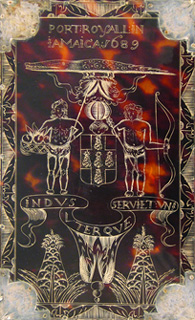Rare Jamaican Artifacts on Display at South Florida History Museum
Port Royal, Jamaica is a ground-breaking exhibit that brings rare artifacts from the legendary Caribbean city to Miami. In 1692, a devastating earthquake sunk most of Port Royal into the sea, just 27 years after its founding. But in that short period of time, Port Royal rose to prominence as a cosmopolitan city where a wealthy minority lived off the economic boon of the slave trade and the bounty of privateers. Over the years, splendor and swashbuckling gave Port Royal the reputation of “wickedest city on earth.”
For some, the natural disaster seemed to be God’s way of curbing excess. Within minutes, the sea poured in and the earth swallowed 25 of the city’s 60 acres. 2,000 people were killed instantly and 3,000 more eventually became victims of injury, illness and crime. Even though the city rebuilt itself as a strategic naval base, it would never again regain its status as a prosperous community. Port Royal would be wicked no more.  Over 150 artifacts are on display at the museum, most of which were gathered from underwater ruins. Many of the artifacts are small, practical items that people used everyday – a wine glass, a German stoneware cup, a red clay pipe, a pewter plate and a Chinese porcelain incense burner—to name a few. Some of the artifacts are bent and twisted from the earthquake, but most are nearly intact. All are beautifully preserved, regardless, and bring the city to life, with evidence of the skilled craftsmanship that supported a genteel colonial lifestyle. I’m always intrigued by artifacts because they tell a story. For me, the tortoiseshell combs, which are carved with exquisite detail, were especially poignant. My imagination did not have to travel far to see a lady having her tresses combed before a ball, but the thought of such luxury makes me shudder, too. Was her maid an indentured servant? Quite possibly. Since I use technology to communicate everyday, I found the books, letters and charts particularly intriguing. One letter, written by an admiral to the Secretary of War had such beautiful penmanship that I had to wonder about the man sitting at a desk, writing by candlelight, dipping his quill in the ink and slowly putting words to paper. Would I write any differently if I wasn’t used to tossing off an email at a moment’s notice? The Wickedest City on Earth Comes To Miami The artifacts from Port Royal may tell you a different story, depending on what strikes your fancy. But one story is the same for all us; we’re very fortunate to be able to see rare artifacts from a neighboring country without having to board a flight, thanks to the preservation efforts of The Institute of Jamaica. Wayne Modest, director of Museums of History and Ethnography at the Institute, spoke to me about the Miami-Jamaica collaboration. “Most of the objects we’ve collected have never left the island. This is the largest collection ever displayed outside Jamaica.†Miami was chosen in part because of its Jamaican community. “We want to share Jamaican history with Jamaicans everywhere,†Modest explained. “But it’s also important to show the world a different side of Jamaica. There’s much more to the island than sand, sea and sun. There’s a strong tradition of collecting and preserving in the Caribbean as a whole.†When You Go When you go, give yourself at least a full hour to browse the artifacts and read the text panels, which provide an easy-to-follow overview of Port Royal’s history. (The visitor’s booklet also contains the same information.) You’ll also want to spend some time looking at the gorgeous black and white photographs of Port Royal taken during the 1980s by Maria LaYacona, a leading Jamaican photographer. The exhibit runs through June 3, 2007 and features ancillary programs related to the exhibit and Jamaican culture.
You Deserve More Than an Ordinary Vacation.
Travel with Miami Beach 411 Today!
The Miami Beach 411 Travel Store is Open 24/7.
4 Comments on"Rare Jamaican Artifacts on Display at South Florida History Museum"
|

Like what you see? Let's talk about how
we can help your vacation --> Contact Us |
|
Like what you see? Let's talk about
how we can help your vacation
--> Contact Us
how we can help your vacation
--> Contact Us
















Luc Bodenhemier says:
I have found what I believe to be a 16th or 18th century Anfora. Where would I go to have it authenticated and possibly sell?
Posted on 04/14/2007 at 7:19 AM